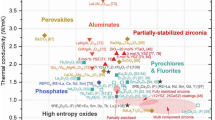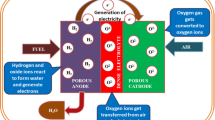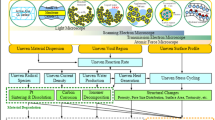Abstract
Substoichiometric titanium oxides are attractive thermoelectric materials for high-temperature modules. Their advantages are availability, economy, and safety. This paper gives results of thermoelectric data on scale-up titanium suboxides, manufacturing technologies of TiO x modules, glass coating as an option for oxidation protection, and test results of TiO x modules. The thermoelectric efficiency of TiO x is low compared with established thermoelectric materials. However, TiO x is very attractive for economic reasons, and there are still expectations for efficiency rise by modification of the material’s microstructure. TiO x can be produced in large quantities of several tens of kilograms. A manufacturing process for TiO x -based unileg n-type modules has been established, including all technological steps. The design of the TiO x -based modules was optimized for the thermoelectric conversion process and thermal robustness. A test device was used for experimental analysis with maximum temperature of 600°C at the hot side and 100°C at the cold side. This initial test revealed similar power output and internal resistance of all fabricated modules. Furthermore, thermal cycles with increasing and decreasing temperatures at the hot side were realized to characterize the reliability and stability of the modules. Additionally, modules were tested in a hot gas test rig to simulate the thermal stresses during power generation in the exhaust line of a passenger car.
Similar content being viewed by others
References
A.D. Pearson, J. Phys. Chem. Solids 5, 316 (1958).
G. Eriksson and A.D. Pelton, Metall. Trans. B B24, 795 (1993).
I. Tsuyumoto and H. Uchikawa, Mater. Res. Bull. 39, 1737 (2004).
M. Backhaus-Ricoult, J. Rustard, L. Moore, C. Smith, and J. Brown, Appl. Phys. A (2014). doi:10.1007/s00339-014-8515-z.
M. Backhaus-Ricoult, J.R. Rustad, D. Vergheese, I. Dutta, and K. Work, J. Electron. Mater. (2012). doi:10.1007/s11664-012-2019-4.
S. Conze, A. Poenicke, H.-P. Martin, A. Rost, I. Kinski, J. Schilm, and A. Michaelis, J. Electron. Mater. (2014). doi:10.1007/s11664-014-3128-z.
S. Conze, I. Veremchuk, M. Reibold, B. Matthey, A. Michaelis, Yu Grin, and I. Kinski, J. Solid State Chem. (2015). doi:10.1016/j.jssc.2015.04.037.
Acknowledgements
We would like to acknowledge the financial support of parts of the presented work by the Federal Ministry of Education and Research (BMBF; 03X3548G, 03X3548E, 03X3548A) and the Saxon Ministry of Science and Arts (SMWK; 100111673, 100111525).
Conflict of interest
The authors declare that they have no conflict of interest.
Author information
Authors and Affiliations
Corresponding author
Rights and permissions
About this article
Cite this article
Martin, HP., Pönicke, A., Kluge, M. et al. TiO x -Based Thermoelectric Modules: Manufacturing, Properties, and Operational Behavior. J. Electron. Mater. 45, 1570–1575 (2016). https://doi.org/10.1007/s11664-015-4115-8
Received:
Accepted:
Published:
Issue Date:
DOI: https://doi.org/10.1007/s11664-015-4115-8




